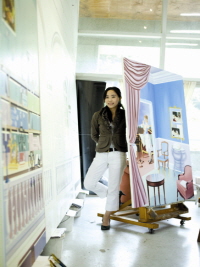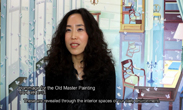Kyungmin NAM's Solo Exhibition_curated by Sung Mi HONG
Nam Kyung Min is curious about artists who have opened new worlds this way and their studios. For this reason, Nam invites artists and their studios into her paintings. She collects materials relating to studios of the artists, and then reproduces their studios based on those materials. Sometimes, she uses archival materials like photos, and other times, images in pictures as sources for her paintings. Nam does not depict studios of masters as they are. Ordinarily, by undergoing a process of borrowing, editing, and reconstructing partial images, and typical iconography and semiotics, she overlaps a master's studio on a symbolic space created by the concept of the artist herself. This overlapping is so close that the viewers cannot separate the master's studio from the artist's conceptual space. Perhaps this overlapping can be seen as a concept coming into confluence with another concept rather than a relation between one studio and another studio, that is, a master's conceptual space and the artist's conceptual space are interwoven into a fabric. Such interwoven space is opened as the third place, and it is space which does not strictly belong to either the artist or the master. This third place and space should be the ultimate destination toward which Nam Kyung Min's painting aspires. Nam intends to metaphorically mark the geopolitical coordinates on the map of painting. Her process recalls Gadamer's "Fusion of Horizons." In other words, the horizon of a master (the other) and I (the subject) are fused into one to open a third horizon. With this newly opened horizon as a medium, the master and I come to exchange and interact, and by doing so, the master is absorbed as a part of my personality. In order to realize such close exchange, Nam invites great painters into her painting: Cezanne and Mondrian, who dreamed of a world of pure geometric forms; Vermeer and Monet, who opened new horizon of painting with velvety gentle light texture and optical light; van Gogh, symbol of emotionalism and pathos; Modigliani imparting melancholy with a long neck and sad eyes; Moreau, master of mystical symbolist art; Magritte, who held conceptual art by alchemy of language and symbol as medium; Hockney, a pop artist who referred to his homosexuality in his work; Frida Kahlo, a revolutionary artist who reflected her personal traumas in her work; Matisse, an optimist who wanted to do paintings as inviting as an easy-chair (nevertheless, it is ironic that he is dubbed the leader of Fauvism); and Richter, who crisscrossed abstract and figurative arts and blurred the boundaries between painting and photography.















